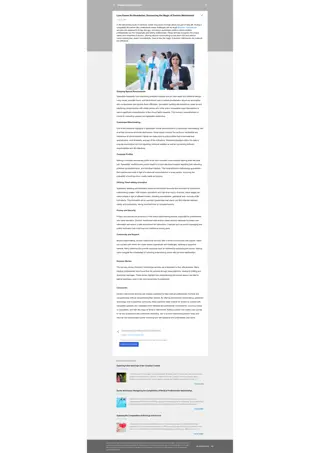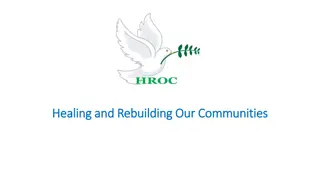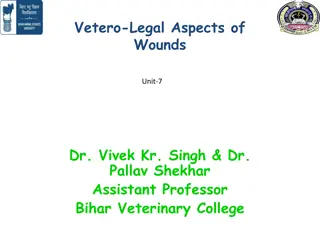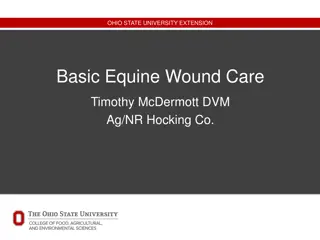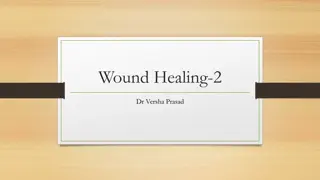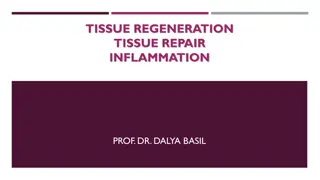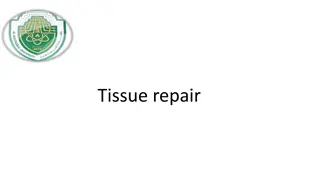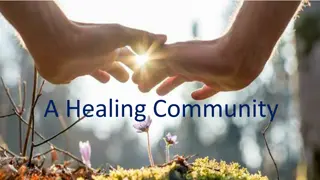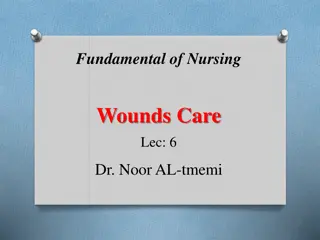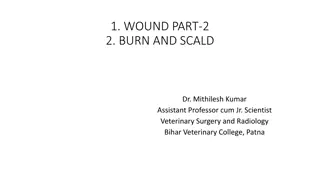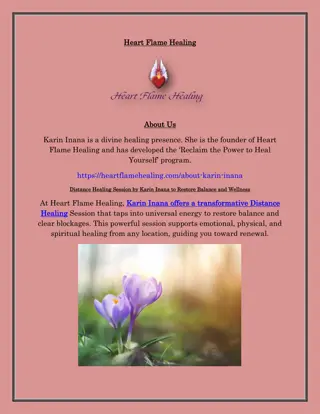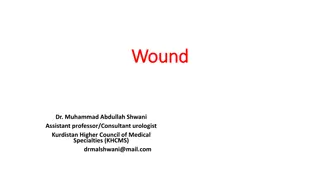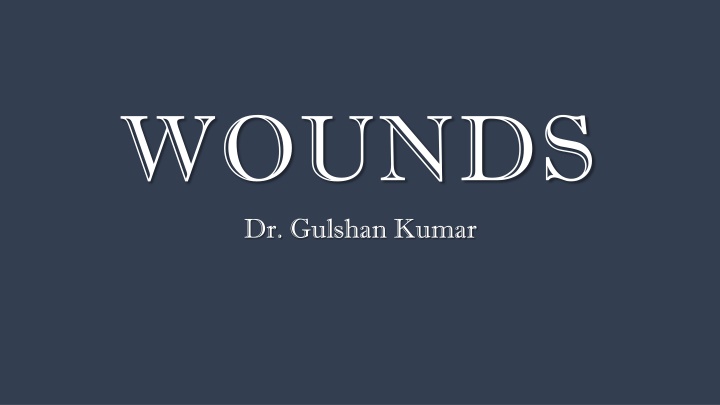
Healing and Regeneration Process in Wounds
The process of healing and regeneration in wounds involves various stages such as clot formation, inflammation, migration of fibroblasts, and tissue repair. Different tissues have varying regenerative abilities, with the skin being a good regenerator while muscles mainly undergo hypertrophy. Understanding the mechanisms of primary and secondary intention healing can help in promoting effective wound healing outcomes.
Download Presentation

Please find below an Image/Link to download the presentation.
The content on the website is provided AS IS for your information and personal use only. It may not be sold, licensed, or shared on other websites without obtaining consent from the author. If you encounter any issues during the download, it is possible that the publisher has removed the file from their server.
You are allowed to download the files provided on this website for personal or commercial use, subject to the condition that they are used lawfully. All files are the property of their respective owners.
The content on the website is provided AS IS for your information and personal use only. It may not be sold, licensed, or shared on other websites without obtaining consent from the author.
E N D
Presentation Transcript
WOUNDS Dr. Gulshan Kumar
Healing Regeneration By mitosis of adjacent tissue If epidermis is a very good regenerator Bone is best regenerated though takes long Liver- hepatocytes again and again, chronic hepatitis-cirrhosis Kidneys- endothelial linings of renal tubule but not glomerulus Alveoli- if basement membrane intact . Can regenerate not chronic Muscles- only hypertrophy .fibrous tissue fills space& nerves no
Healing Fibrosis and scar tissue formation-other tissue fills space
Healing Two ways: Primary intent: edges are approximated- essentially If clean, no foreign body, no necrotic tissue primary healing can take place or. Then the edges can be approximated for primary intention healing Good functional results, cosmetic, early healing Secondary-If not clean, or foreign body, or necrotic tissue Delayed primary .
Healing Two ways: Primary intent: edges are approximated- essentially If clean, no foreign body, no necrotic tissue primary healing can take place or. Then the edges can be approximated for primary intention healing Good functional results, cosmetic, early healing Secondary- If not clean, or foreign body, or necrotic tissue Tissue loss healing by granulation Delayed primary .
Healing Same stages: whether primary or secondary Bleeding- clot Dries on top to form a scab. Injured tissue cytokines Neutrophils Inflammation PMN in large nos within 90 minutes Phagocytose bacteria and necrotic cell Cytokines monophages (become macrophages) growth factors Mitosis and migration of FIBROBLASTS into the wound DISTRUCTIVE/MIGRATORY phase
Healing Plasminogen in clot converted to plasmin (Enzyme) Plasmin digests Blood clot (Fibrin strand mesh)-FIBRINOLYSIS Macrophapage growth factor causes migration of epithelial cell under the clot if relatively small/surgical wound in <48 hrs Fibroblasts secrete collagen strands- protein high tensile strength edge-to-edge connection -filling and binding (earlier filled by fibrin in clot) Fibroblasts also secrete ground substance/matrix-glycoprotein
Healing Macrophage growth go to adjacent injured blood vessels and initiate mitosis in the endothelial cells- move into the wound ANGIONEOGENESIS New capillaries bring nutrition and oxygen Lymphocytes also reach wound plasma cells antibodies Y immunoglobulins for immunity Scab and epithelial layer keep the interiors of the wound moist to allow migration of mediators and cells and nutrition etc. if dry .delayed or This all is GRANULATION TISSUE
Healing Similar things happen in large scale in large wounds forming scar Cicatrix PROLIFERATION/GRANULATION phase Then comes MATURATION / REMODELLING for ..long periods Scars get smaller & fade
Wound management: Considerations Haemostasis methods.. When to and when not to Pain management LA but should not contain adrenalin vasoconstriction Wound assessment/exploration extent contents
Wound management: Considerations Clean ..when dirty.. remove foreign material etc Large volumes of sterile Saline Tap water helps removal of gross contaminants ..wound toilet. Finally irrigate with sterile Saline avoid splashing Choose method of healing Pri.. Sec Delayed primary closure.
Factors affecting Wound healing: Local Desired: Quick healing with good functional and cosmetic result; without complications Local factors adversely affecting wound healing Infection causing inflammation toxins continuous insult to tissue ..delay healing Diagnosis of specific infection helps to manage them.. Systemic antibiotics .. But antibiotics do not hasten healing. Pressure closes capillary circulation reducing the blood supply needed for healing .for nutrition oxygen. Mobility of edges shearing forces
Factors affecting Wound healing: Systemic Nutrition healing is a metabolically demanding process Carbohydrates for energy enough calories to be supplied Proteins essential amino acids building antibodies Essential fatty acids Vitamins especially C essential for collagen formation Minerals esp Zn..cofactor for several enzymes.. Also for epithelialization.. But not mega doses of vit C or Zn Age Young animals heal faster as compared to older ones Olders ones can be having co-morbidities of poor nutrition Delayed inflammatory response.. Especially when on steroidal drugs Hyper/hypothermia Enzymic activity is affected .. Vaso constriction due to hypothermia
Factors affecting Wound healing: Systemic Stress/anxiousness adrenal stimulation lowers inflammatory response Hypoxia .oxygen is vital to provide Compromised immunity.. Risk of infection ..delay Hyperglycaemia glucose substrate for bacteria risk of infection More glucose in interstitium . prevents migration of neutrophils and monocytes hence reduce efficiency of phagocytosis .
Factors affecting Wound healing: Local Necrotic tissue substrate for bacteria Sets up infection Cellular migration requires live/viable tissue .. Living cells do not migrate over dead tissue. Necrotic tissue Includes pus too . So debride it Foreign material Living cells do not migrate over foreign material. Mobility of edges shearing forces Nature of the wound.. Eg high energy wounds automobile accidents Force of impact disrupts blood supply .delay Jagged or unclean .promote risk of infection . delay Wound cooling coagulopathy .clots best at physiologic temp. Enzymic activity is also reduced due to hypothermia


